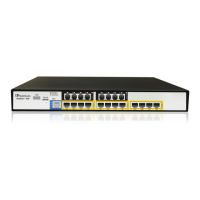Note: For this parameter to take effect, a device reset is required.
66.2.4 SNMP Parameters
The SNMP parameters are described in the table below.
SNMP Parameters
Parameter Description
Web: Enable SNMP
CLI: disable
[DisableSNMP]
Enables SNMP.
[0] Enable = (Default) SNMP is enabled.
[1] Disable = SNMP is disabled and no traps are sent.
CLI: port
[SNMPPort]
Defines the device's local (LAN) UDP port used for SNMP
Get/Set commands.
The range is 100 to 3999. The default port is 161.
Note: For this parameter to take effect, a device reset is required.
[ChassisPhysicalAlias]
Defines the 'alias' name object for the physical entity as specified
by a network manager, and provides a non-volatile 'handle' for
the physical entity.
The valid range is a string of up to 255 characters.
[ChassisPhysicalAssetID]
Defines the user-assigned asset tracking identifier object for the
device's chassis as specified by an EMS, and provides non-
volatile storage of this information.
The valid range is a string of up to 255 characters.
[ifAlias]
Defines the textual name of the interface. The value is equal to
the ifAlias SNMP MIB object.
The valid range is a string of up to 64 characters.
EMS: Keep Alive Trap Port
[KeepAliveTrapPort]
Defines the port to which keep-alive traps are sent.
The valid range is 0 - 65534. The default is port 162.
[SendKeepAliveTrap]
Enables keep-alive traps and sends them every 9/10 of the time
as defined by the NATBindingDefaultTimeout parameter.
[0] = Disable
[1] = Enable
Note: For this parameter to take effect, a device reset is required.
CLI: sys-oid
[SNMPSysOid]
Defines the base product system OID.
The default is eSNMP_AC_PRODUCT_BASE_OID_D.
Note: For this parameter to take effect, a device reset is required.
[SNMPTrapEnterpriseOid]
Defines the Trap Enterprise OID.
The default is eSNMP_AC_ENTERPRISE_OID.
The inner shift of the trap in the AcTrap subtree is added to the
end of the OID in this parameter.
Note: For this parameter to take effect, a device reset is required.
[acUserInputAlarmDescriptio
n]
Defines the description of the input alarm.

